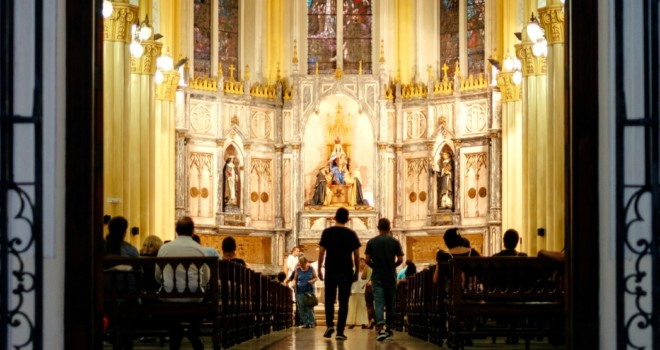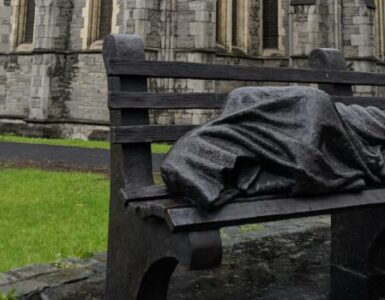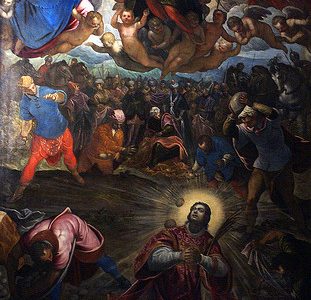One of the cardinal virtues, and one of the virtues that people most associate with morality, is the virtue of justice. The classical definition of justice is the virtue whereby we fulfill our obligations toward others.
Now,
who is the other toward whom we are most obliged? Obviously, it’s God.
Justice toward God, then, is the primary mode of justice. Aquinas calls justice toward God the virtue of religion and says that it’s the highest of the moral virtues. And what does this virtue of religion consist in? Quite simply, it consists in offering worship to God — or, more specifically, “in offering service and ceremonial rites or worship to some superior nature that men call divine.” This is the supreme act of justice, the highest of the moral virtues. As we say during Mass, giving God thanks and praise is “right and just.”
So, the center of a moral life, and consequently of the Christian life, must be the Mass. When Vatican II says that the celebration of the Eucharist is “the source and summit of the Christian life,” it’s not just making a liturgical pronouncement — it’s making a moral statement. It’s saying that this is how we are supposed to live, with the Mass as the foundation and high point of everything we do.
We can make a few general comments about avoiding typical errors when it comes to the role of sensible beauty in the liturgy. These errors can, I think, be grouped under two general categories: first, an excessive focus on liturgical beauty, and, second, an insufficient focus on liturgical beauty. Showing the weaknesses in these extremes will hopefully clarify the way beauty should enhance, but not distract from, our highest service to God.

Excessive Focus on Sensible Beauty
It might be counterintuitive to begin a discussion on
liturgical beauty by making the claim that we could focus “too much” on the
sensible beauty of the liturgy. But, of course, we can focus too much on anything
created — and art is a creation and a human creation, at that.
So how do we know when our focus on a created thing is becoming
disordered? Easy: it happens when we find that it’s
getting harder to focus on God.
Now, this disordered focus on artistic beauty in the liturgy —
which distracts the mind from God instead of
leading the mind to God — can show itself
in different ways.
Many of us have probably been to Masses where all the focus seemed
to be on the music — or, more likely, on the choir. The orchestral arrangements
may be exquisite, the execution very fine, but if we’re just appreciating the
quality of the music, we’re not doing what we’re supposed to be doing in Mass.
A
choir, especially an excellent choir, has to have enough humility to resist
the urge of turning the Paschal Mystery into a concert. And, by the way, it’s
not just choirs that have to be careful. It has become common at youth Masses
to center the whole “experience” on rock musicians. But you can’t turn liturgy
into an excuse for a rock concert. It’s about the Eucharist, not the band and
not the music.
The same misdirection can happen with both art and architecture.
Giotto’s Arena Chapel, covered with an astonishing array of splendid frescoes,
is a breathtaking achievement — but it seems more designed to showcase his
artistic brilliance than to direct attention toward the sacrifice of the Mass.
Could one conceivably concentrate on the Eucharistic sacrifice when such colors
and representations call to you from every side?
Unless those in charge of liturgical art, music, and architecture realize that the worship of God is more important than a work of art, the art itself will become corrupted by a disproportionate focus on its function.
This doesn’t mean we should work to make the music, sculpture, or architecture less beautiful — only that we have to make sure these creations facilitate the praise of God, instead of focusing our attention on the art itself.
Another
way we know we are placing a disordered focus on sensible beauty in the liturgy
is when ugliness or poor taste in the liturgy prevents
us
from praying. If the absence of sensible beauty can keep you from thinking of
God, it proves that you’re too attached to sensible beauty.
If we attend Mass in ugly surroundings — drop-ceilings and florescent lights, lame music and weird art — we don’t have to like it, but if we spend all our time mentally complaining about the defects in the aesthetics and forget that Christ is there, through the ministry of the Church, however banal the liturgical trappings, that’s the sign of a superficial relationship with Christ. It means we’ve focused too much on the sensible characteristics surrounding Christ’s Body, the Church, instead of seeing Christ in His Body, despite its spotted or wrinkled appearance.
In
a letter to his son, J. R. R. Tolkien once gave a piece of extraordinary
advice:
I can recommend this as an exercise [alas! Only too easy to find opportunity for] . . . : make your Communion in circumstances that affront your taste. Choose a snuffling or gabbling priest or a proud and vulgar friar; and a church full of the usual bourgeois crowd, ill-behaved children. . . . Go to Communion with them (and pray for them). It will be just the same (or better than that) as a mass said beautifully by a visibly holy man, and shared by a few devout and decorous people.
The point isn’t to undermine the importance of beauty in the liturgy. It’s to remember that Christ is there, regardless of appearances, and if we lose sight of that, we’ll have lost sight of what the Mass is — and so lost sight of the structure of human life for which liturgy is the foundation and ultimate goal.
Insufficient Focus on Sensible Beauty in the
Liturgy
Indifference to beauty in the liturgy typically indicates a lack of concern for what matters most. A parish that doesn’t make any effort to beautify the Church’s worship probably doesn’t make much of an effort to proclaim the Church’s doctrine or the Church’s moral teaching either.
So why is there so much ugliness and banality
in so many parishes today? If you need beauty to perfect every other facet of
life — to perfect it and make it delightful — why would you allow the liturgy,
the most important aspect of human existence, to degenerate into something
bizarre or boring, and frequently both?
Again, the cause
is probably twofold.
Most likely, there’s an unwillingness to invest in
glorifying God. Some people just don’t care enough about God’s glory to “waste”
our resources in praising Him. People spend money only on things that are
important to them. They’ll spend an awful lot of money on their own houses, but
they won’t be as eager to contribute to the magnificence of God’s house.
Sometimes, if people are socially conscientious in a way, they’ll discourage the use of money, time, and artistic skill on religion, insisting that it would be better spent on the poor. Lavish expenditure on God will always be a waste in the eyes of the faithless.
The Catholic Church defies the false dichotomy in which care for the poor is opposed to elaborate beauty directed to the worship of Christ. The Catholic Church is the largest charitable organization in the world as well as the greatest proponent of beauty in the history of the human race. She builds statues, mosaics, and frescos, all to house the living God in His tabernacle. And she does this because she recognizes that it’s integral to her mission of saving the world.
Priests, especially, have to be equipped to promote beauty in liturgical art. Vatican II says that “great importance is to be attached to the teaching and practice of music in seminaries, in the novitiates and houses of studies of religious.” Similarly, Pope Benedict XVI said, “It is essential that the education of seminarians and priests include the study of art history, with special reference to sacred buildings and the corresponding liturgical norms. Everything related to the Eucharist should be marked by beauty.”
If you’re a Catholic, and especially if you’re a Catholic priest,
who thinks of beauty as a side interest for people with too much time and money
and too little charity — if that’s your attitude toward beauty, especially in
the liturgical life of the Church, then it’s time to reconsider.
Indulgence in Disorder
At the other end of the spectrum are the people who make the mistake of indulging in disorder, trying to achieve surprise at any cost, in an effort to be daring or “engaging.” When people try to be new in a way that isn’t proportionate to the setting — in this case, worship of the majestic, all-holy God — the result is just weird. Weird buildings, weird music, weird art.
Don’t give in to the desire to be “daring,” to be hip, to be culturally avant garde, to be relevant or engaging.
Don’t worry about being cool. Worry about making things beautiful. If you aim for surprise, you won’t get beauty, but if you aim for beauty, you’ll get surprise along with it. And you’ll get order and proportionality — in terms of our past, our future, and the glory of God. And this, after all, is the purpose of the whole thing — of all created beauty, sacred music, sacred art, sacred space.
✠
This article is adapted from a chapter in Dr. Miravalle’s Beauty: What It is and Why It Matters. It is available at your favorite bookstore or online through Sophia Institute Press.
Photo by Yannes Kiefer on Unsplash














